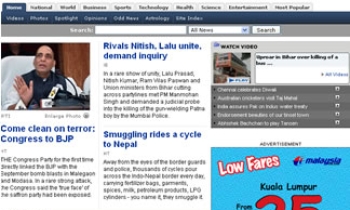Finding out for free what New York Times columnists think about events at home and abroad ended yesterday when the newspaper started charging a fee to access its Web site.
In a bid to generate more money from nytimes.com and support new journalism initiatives, the Times has stopped free online access to 22 columnists, including Thomas L. Friedman, Maureen Dowd and Paul Krugman. People who subscribe to the print edition will not be charged an additional fee for the new service, which is called TimesSelect. The price tag for the service is $49.95 a year or $7.95 a month.
TimesSelect represents a major departure for the company, which heretofore hadn't tacked on a fee to enter nytimes.com, except for a narrow range of material such as crossword puzzles, an archive of old stories and a customized news report delivered via e-mail. Among large papers, only The Wall Street Journal has charged a universal Web fee.
Martin Nisenholtz, senior vice president of digital operations at the Times Co., said TimesSelect shouldn't be seen as a step toward converting nytimes.com to a paid site. "We're not gating the whole site - 97 percent remains free," he said.
The most popular newspaper site, nytimes.com, had 12.5 million unique visitors last month, according to Nielsen//NetRatings.
Nisenholtz also said the Times hopes to generate more revenue to support journalism on the Web.
"My vision for this is that it becomes a really, really rich interesting place for Web journalism," he said. "In order for great journalism to persevere over the long term, it needs to be financed."
In addition to their columns from the print edition, many Times op-ed writers are working on material that will be available only to TimesSelect subscribers. Bob Herbert plans to write about unsung heroes across the country while John Tierney is starting a virtual book club.
Nisenholtz predicted that non-Times journalists eventually would be included in the TimesSelect space. It already encompasses the e-mail alerts service and access to the paper's archives.
Asking people to pay for Web content isn't without pitfalls. In May, the Los Angeles Times stopped charging for its online entertainment guide after readers balked at paying $60 a year. CalendarLive.com had begun in August 2003.
Only 39 of the roughly 1,500 newspaper Web sites levy an entrance fee, according to the Newspaper Association of America, an industry trade group. Of the paid sites, nine provide sports coverage and two have substantially more subscribers than their companion print editions: postregister.com of Idaho Falls, Idaho [CORRECTION: Postregister.com, the Web site of the Post Register newspaper of Idaho Falls, Idaho, has fewer subscribers than its companion print edition. A story yesterday incorrectly described the number of online subscribers. pg. A21 ALL 09/21/05], and wsj.com, the online edition of The Wall Street Journal.
Melinda Gipson, the association's director of electronic media, said, "What The New York Times is doing is unique ... [and] it shows the Web is no longer a grand experiment but a way for publications to reach out to new audiences."









